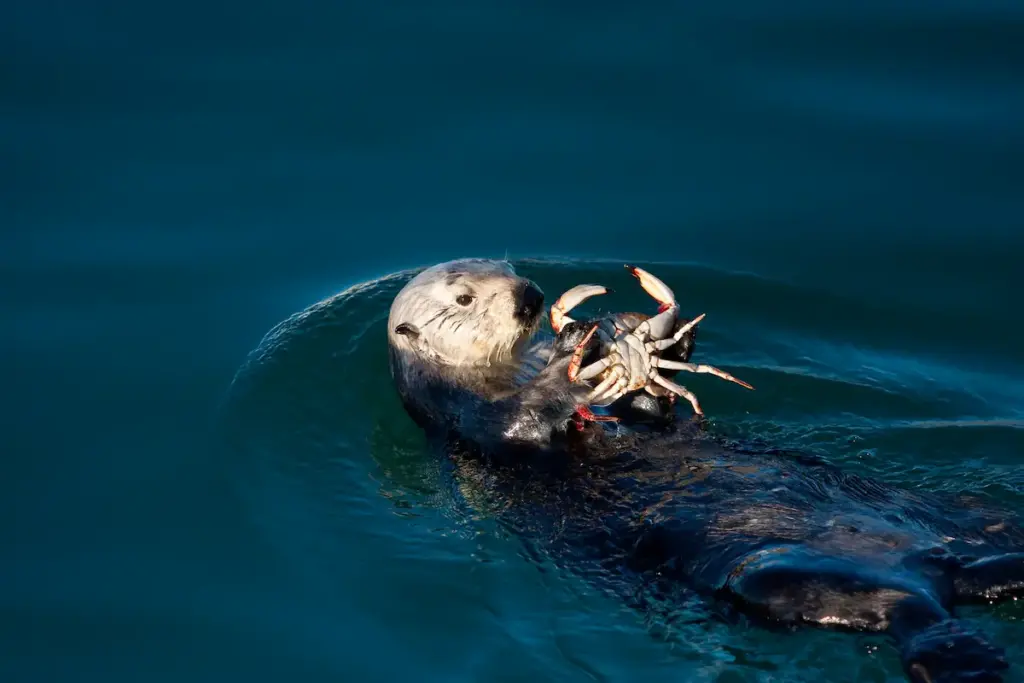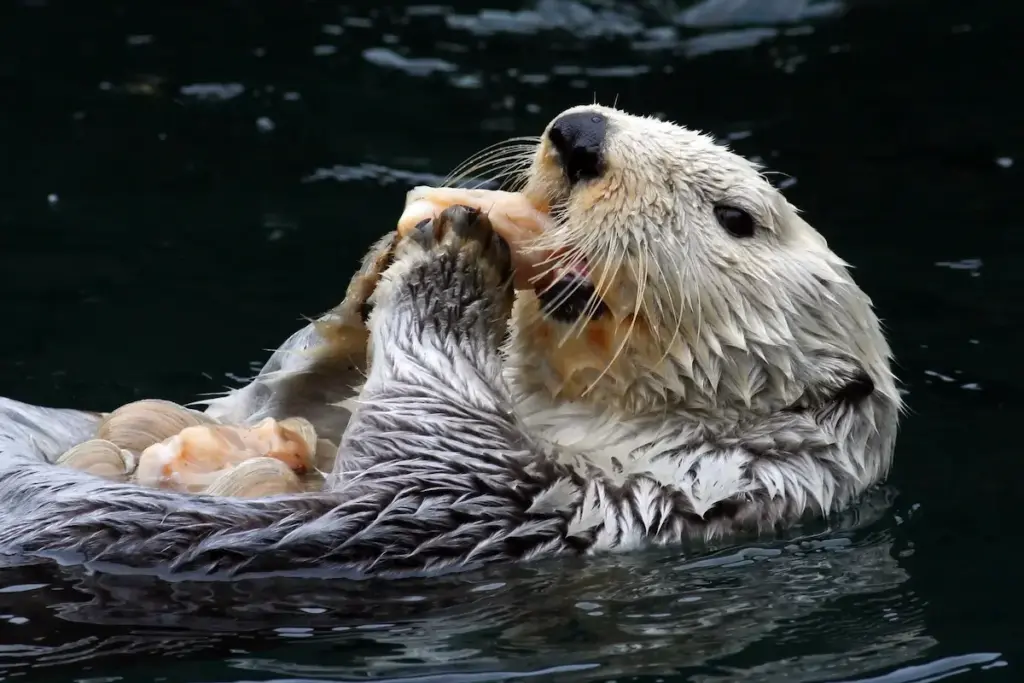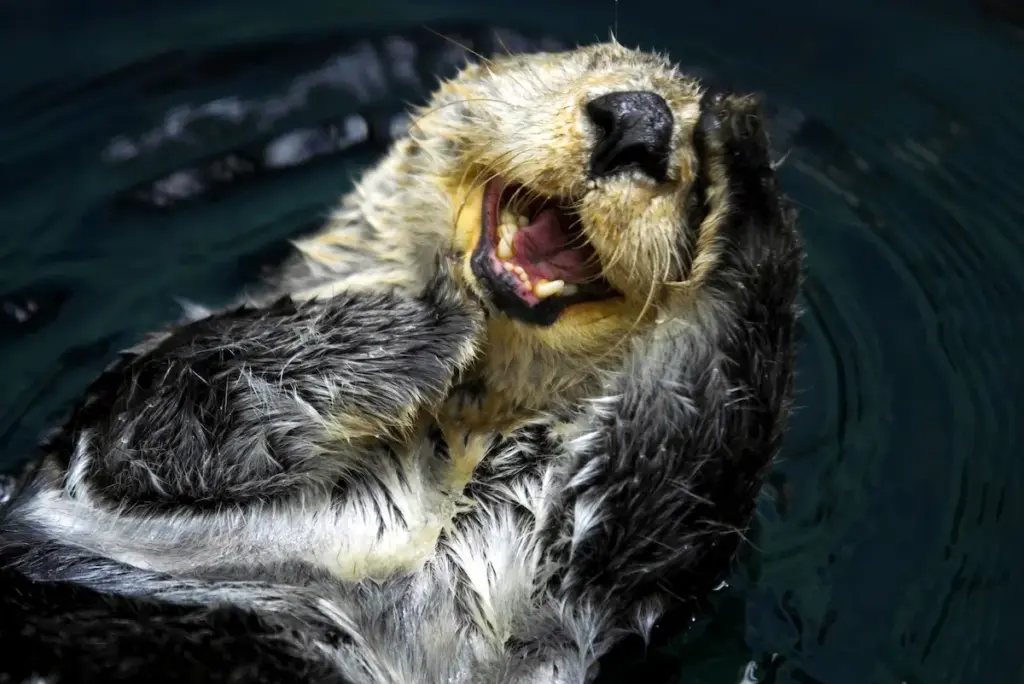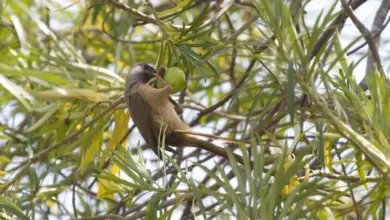Otters are semi-aquatic mammal species that can be found in many watery habitats including rivers, lakes and wetlands. Their diet is unique and suited to the aquatic lifestyle. This article will explore the otters’ diet as well as what they eat.

What eats Otters and Why? Otter Predators
Although they are agile and quick in the water, otters have many natural predators that need to be watched.
What predators eat otters depends on their location and species. They all all kinds of food. Here are the top predators that threaten otters.
Land Predators
Land predators can catch otters as they come onshore or land to give birth. Land predators catch otters when they are on land or come to shore.
- Bears – In North America, the bear is a major predator. Bears – Grizzly, black, and polar are all known to hunt otters for food.
- Wolves & Coyotes: Wolves and Coyotes can be dangerous to otter puppies if their mothers leave them unattended for even a short time. These predators may also attack weaker adults and juvenile otters.
- Big Cats – In certain parts of the globe, big cats like leopards, jaguars and cougars hunt otters. They ambush and stalk them on land or shallow water.
- Eagles: Large predatory birds, such as bald eagles will grab otter pups near the shoreline or in shallow water.
Aquatic Predators
Otters need to be on the lookout for sharks, crocodiles and killer whales. They also have to keep an eye out for large predatory fish.
- Sharks: Some shark species, particularly smaller sea otters will prey on them opportunistically. Otter predators include great white sharks and tiger or bull sharks.
- Crocodiles: Crocodiles can easily catch otters from murky waters in estuaries or rivers. They are dangerous because of their powerful jaws and lightning fast strikes.
- Killer Whales- Killer Whales are the primary predators of sea Otters. They can hunt and eat a large number sea otters using coordinated hunting techniques.
- Moray Eels: Giant morays and other large species of eels may feed on young or smaller Otters. Their sharp teeth are capable of delivering a vicious bite.
- Snakes: Large anacondas, pythons and other snakes can suffocate and constrict otters. Water snakes can also feed on otter pups.

Additional Threats
Apart from predation by humans, otters are also threatened by human activities such as habitat destruction, pollution and oil spills.
The dangers listed above can cause otters to die or reduce the food they consume. Vehicle strikes on land are another danger as otters travel between waterways.
What do Otters eat? Otter Diets
Let’s look at the otter diet. The eating habits of sea, river and giant otters are different. They eat a range of delicious food and are incredible hunters.
Sea Otters
The main food of sea otters is marine invertebrates. This includes crustaceans such as crabs, mollusks such as clams, mussels and sea urchins, and echinoderms. Their diet includes:
- Crabs
- Clams
- Mussels
- Snails
- Sea Urchins
- Squid
- Octopuses
- Fish
- Shrimp
The sea otter dives to the ocean bottom to hunt prey, and then surfaces to eat as they float on their backs. To crack hard shells, they use rocks. To maintain their high metabolic rate, sea otters eat around 25% of their weight each day.
River Otters
The river otter is a carnivore, which means it feeds on various prey, including those living in rivers, lakes, swamps, and along the coast. They eat a variety of prey, including:
- Fish – carp, perch, suckers, bullheads, sunfish, bass, trout
- Crustaceans (crayfishes, crabs)
- Amphibians: frogs and newts
- Turtles, snakes and small alligators are reptiles
- Birds: ducks, coots and swans
- Insects
- Small mammals, such as rabbits and mice, can be found in the wild.
The river otter is a opportunistic hunter and will take on whatever prey they can find. The otters dive underwater and use their whiskers to detect the prey, even when it is dark or murky. The river otters eat small amounts of food throughout the day.

Giant Otters
The giant otters inhabit the Amazonian rivers as apex prey. They eat mainly fish and can weigh up to 10 pounds a day.
- Piranhas
- Catfish
- Perch
- Characins
- Cichlids
In family groups, they hunt together to capture and surround fast-moving fish. The giant otters are skilled at driving fish into vegetation or mud banks to capture them. Sometimes they will also eat birds, reptiles and small mammals.
Hunting Techniques
Otters are adapted to hunt effectively and have developed specialized techniques.
- In murky water, sensitive whiskers can detect prey through touch
- Sharp claws to grab slippery, wriggling predators
- The muscular tails of the fishes are able to propel themselves through the water.
- Ability to hold breath and dive deep for 4-8 minutes
- The layer of air or water that is trapped between the fur and the skin to keep warm when swimming
- Sea Otters float on their backs to eat in the water.
- Sea Otters using rocks as crude tools to crack open their hard shells
- Families hunting together (giant Otters)
Otters are well-suited to aquatic life because of their speed, agility and ability to catch fish.
Otter Habitats Around the World
Every continent, except Australia and Antarctica, has otters. They live in a variety of marine and aquatic environments. Various otter species are adapted to different habitats:
The northern Pacific Ocean coast is home to sea otters. The sea otters are usually found on shallow, rocky coral reefs offshore with dense kelp forests.
The area is a rich hunting ground, with abundant food like abalones, crabs, clams and sea urchins. The thickest fur on any mammal is found in sea otters to protect them from the cold oceans.
Threats Facing Otters
The otters, while well-equipped as predators are also vulnerable to human activities.
- Habitat destruction reduces the wetland habitats that provide food and refuge. Water quality is also affected by pollution from agricultural and industrial runoff.
- The over fishing of rivers and lakes as well as coastal waters reduces fish populations, which are the main source of food for otters.
- Oil spills can coat the fur, which reduces its water repellent and insulation properties. Cleaning up efforts disturb them further.
- The otters are often killed by roadkill as they move from one aquatic habitat to another.
- In the past, hunting for their thick and luxurious fur played a role. In recent decades, international bans on the fur trade have helped populations recover.
- Zoos, Aquariums and Wildlife Rehabilitation Centers play an important part in the preservation of threatened otter populations through captive breeding programs and re-introductions. They help to offset habitat loss, and other pressures on the wild population.
Wild otter populations will need to be sustained in the future by protecting and restoring wetland habitats. By using careful management practices, you can strike a healthy balance between the human use of landscapes while maintaining healthy ecosystems that support otters.
Summary
Otters play a crucial role in the food chain of both their predators and prey. They are attacked by many natural predators, both on land and in the water. This helps to keep their populations in check.
Otters are expert hunters that eat a wide variety of fishes, amphibians and aquatic invertebrates.
They thrive in rivers and wetlands as well as coastal marine habitats around the globe. This is because they feed on food that is abundant in these habitats. Otters are semi-aquatic, carnivorous animals that have unique hunting habits and skills.




